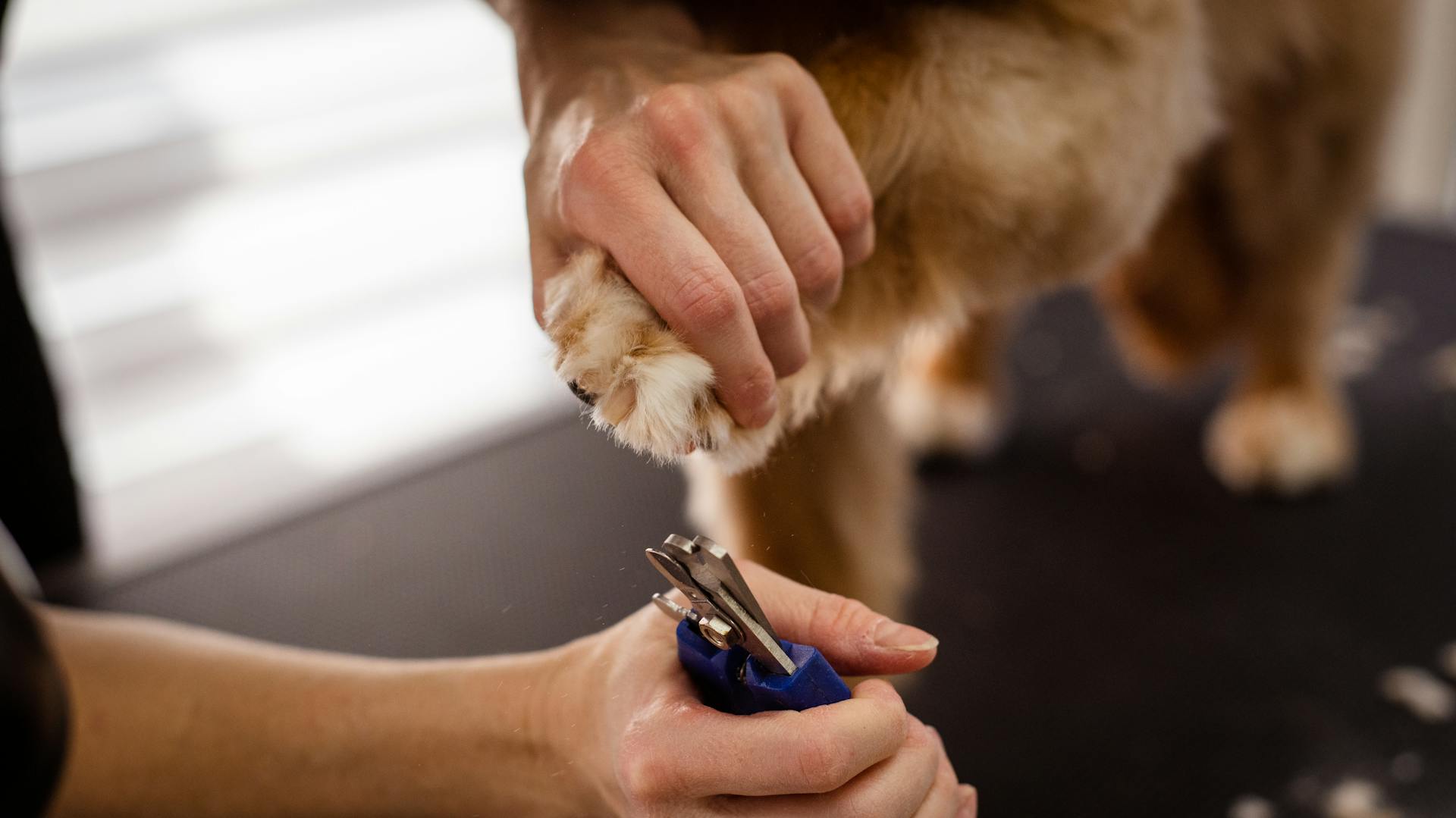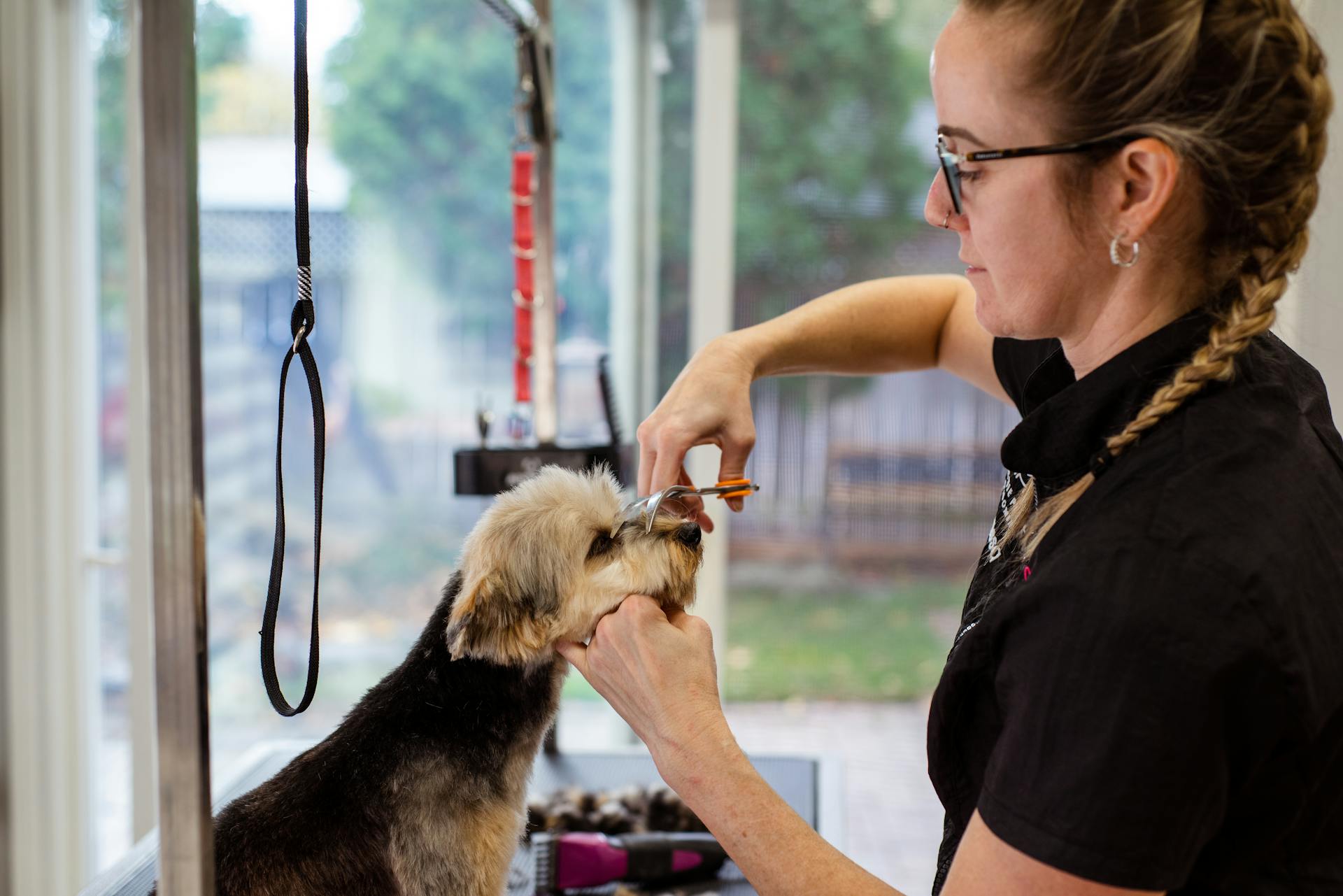
Cutting a puppy's nails is an essential part of their grooming, and it's a skill you can master with a little practice.
You'll want to get started as soon as possible, ideally when your puppy is a few months old, so they can get used to the process.
It's crucial to use the right tools, such as a good quality nail clipper specifically designed for puppies, to avoid causing any discomfort or injury.
Start by gently holding your puppy's paw and identifying the quick, the pinkish-colored part of the nail that contains nerves and blood vessels.
Preparation
Before you start trimming your pup's nails, it's essential to prepare them for the process. Get your dog comfortable before beginning by letting them sniff the nail trimming tool, watch its motion, and listen to the sounds it makes, rewarding them with treats for their bravery.
You can also clip nails in moments when your dog is relaxed and sleepy, such as after a long walk or a lively play session. Prep the area by creating a quiet and distraction-free environment on the floor or sofa or in your lap.
To ensure you have everything you need, gather your supplies, including a nail trimming or filing tool, styptic powder, and treats. Here are the supplies you'll need:
- A nail trimming or filing tool
- Styptic powder
- Treats
Get your dog comfortable with the tools by letting them sniff the nail trimmer and file, and follow it up with a tasty treat. Flex the trimmers a few times to get them used to the noise they make, and then gently touch the clippers to your dog's paw without trying to trim yet.
Gather Your Supplies
Before you start trimming your dog's nails, make sure you have all the necessary supplies close at hand. It's a good idea to gather everything you need in one place to avoid any interruptions during the process.
A nail trimming or filing tool is a must-have for this task. You can choose from a variety of options, but make sure it's suitable for your dog's nail type.
You might like: How to Cut Dog's Nails When They Fight You?
Styptic powder is a useful item to have on hand in case you accidentally cut the quick of your dog's nails while trimming. It helps stop the bleeding quickly and effectively.
Treats are a great way to reward your dog for their patience and cooperation during the nail trimming process. Grab a few of their favorite treats to make the experience more enjoyable for them.
Prepare Dog for Comfort
Get your dog comfortable before beginning nail cutting. This can be scary for many pups, so it's essential to get them used to the process beforehand.
Let them sniff the tool, watch its motion, and listen to the sounds it makes, rewarding them with delicious treats for their bravery. You can do this over a few days to get them comfortable.
It's also helpful to clip nails in moments when your dog is relaxed and sleepy. This could be after a long walk or a lively play session when your dog is calm, tired, and unlikely to become anxious.
Creating a quiet and distraction-free environment is also beneficial. This can be done on the floor, sofa, or in your lap.
Expand your knowledge: When Do Puppys Stop Growing
Choosing the Right Tool
Canines have unique nails that require specialized trimming tools, unlike humans and cats. You can choose between nail clippers and nail grinders, both with their own advantages and disadvantages.
Nail clippers are a popular choice, but they can be challenging to use, especially with thick claws. They come in various configurations, such as guillotine, scissor, and plier styles, which require skill and experience to use correctly.
For larger dogs, nail clippers can be more difficult to use, requiring more pressure and increasing the risk of a rough cut. In contrast, nail grinders are often a safer option for inexperienced dog owners, as they slowly grind down the nail to a smooth finish.
For a more straightforward option, consider using a plier/scissors-style clipper, which is more suitable for larger dogs and those with thicker nails.
A unique perspective: Cut Dogs Nails
Choosing Nail Clippers
Choosing the right nail clippers for your dog is crucial to avoid any accidents or injuries. You have two main options: nail clippers and nail grinders.
Nail clippers are a popular choice, but they can be tricky to use, especially for thick nails. They come in different configurations, such as guillotine, scissor, and plier styles, which require skill and experience to use correctly.
The scissor/plier type clippers are a safer option for larger dogs and dogs with thicker nails. They allow you to cut from multiple angles, making it easier and more comfortable to use.
If you're new to trimming your dog's nails, a nail grinder might be a better option. They use a sandpaper-like material and a motor to shave down nails smoothly, allowing you to stop and check your progress.
Here are the main differences between nail clippers and nail grinders:
Remember, the key to successful nail trimming is to take it slow and be patient. Hold your dog's paw firmly but gently, and slice away at the nail until you can see the quick.
Using Clippers
Using clippers requires some finesse, but with practice, you can become a pro. Clippers give a quick, precise cut, but using them can be difficult if your dog has thick claws.
There are many variations of clippers, including guillotine, scissor, and plier configurations, which require skill and experience to use correctly. For small dogs, clippers usually do an adequate job.
To use clippers safely, you'll want to hold your dog's paw in a firm yet gentle position with your thumb on the pad and your index finger on the top of the foot. Press your thumb up and then backward to extend the nail.
To clip your dog's nails, drape your arms and upper body over the animal. When trimming the front claws, keep your left forearm over the neck to keep the dog from lifting its head. If the dog tries to stand, lean your upper body over its shoulders to prevent it from rising.
Discover more: Can I Use Dog Flea Shampoo on My Cat
You should not cut too short, as the nail will bleed. Nails should be cut from underneath at a 45-degree angle. To avoid catching the quick, cut small slices of nail off, rather than trying to remove a single chunk at once.
Here's a step-by-step guide to clipping your dog's nails with clippers:
- Hold your dog's paw firmly but gently
- Place the tip of the nail in the stationary ring of the trimmer with the clipper perpendicular to the nail
- Squeeze the handle to move the cutting blade
- Cut no more than 1/8" from the nail, and then check to make sure you haven't accidentally cut the quick
Cutting Techniques
To cut your puppy's nails safely and effectively, you'll want to start by holding their paw in a firm yet gentle position. This means placing your thumb on the pad and your index finger on the top of the foot.
Press your thumb up and then backward to extend the nail, taking care not to catch any long tufts of hair between the toes.
The key to cutting puppy nails is to only take off a little bit at a time, especially when they're young. This will help avoid any negative associations with nail clipping.
You'll want to move to a nail grinder or dog nail scissors once your puppy's nails become a little thicker, which is usually around 12 weeks of age.
Remember to trim the dewclaw, which is located higher up on your pup's leg, as it's an important part of the nail-cutting process.
Here are some key tips to keep in mind:
- Reward your puppy with treats after every nail clip to associate it with a positive experience.
- Handle your puppy's paws often and rub the clippers onto their paws without using them to help them get used to the sensation.
- Don't be nervous or afraid, as your puppy will pick up on your fear and try to escape.
- The best time to cut your puppy's nails is after a bath, when they're more relaxed under warm water.
- Don't cut all nails at once - extend the procedure over a few days if needed.
- Don't forget to cut the dewclaw, and be aware that some dogs may have back dewclaws as well.
Safety Precautions
Safety Precautions are a must when cutting your puppy's nails. Many dogs will happily sit still for nail trimming, but some require restraint.
To keep your puppy safe, it's recommended that owners learn to trim their dog's nails from a veterinarian or veterinary technician first. This will help you understand the best techniques and get comfortable with the process.
You should drape your arms and upper body over the animal to keep them calm and secure. This is especially important when trimming the front claws, as you'll want to keep your left forearm over the neck to prevent the dog from lifting its head.
Suggestion: When Do Puppys Open Their Eyes
Nail Bleeding
If you accidentally cut the quick, don't panic. Your dog could think the situation is more serious than it is, which may cause them to form a negative association with getting their nails trimmed.
Apply styptic powder to the affected nail until it stops bleeding. This will help stop the bleeding quickly and effectively.
Give your dog a treat and some reassurance after the bleeding has stopped. This will help them associate the nail trimming process with positive reinforcement.
Do You Clip Safely?
Clipping your dog's nails safely requires some finesse. You should learn to trim your dog's nails from a veterinarian or veterinary technician first.
Many dogs will happily sit still while you trim their claws, but others need some form of restraint. Drape your arms and upper body over the animal to keep it calm.
To prevent your dog from lifting its head, keep your left forearm over its neck while trimming the front claws. This simple move can make all the difference.
If your dog tries to stand, lean your upper body over its shoulders to keep it from rising. This is a crucial step in keeping your dog safe.
When trimming, grip each individual toe firmly with your thumb and forefinger. This will help you maintain control and avoid accidents.
Place the tip of the nail in the stationary ring of the trimmer with the clipper perpendicular to the nail. This is the safest way to trim your dog's nails.
Remember, don't cut too short, as the nail will bleed. It's better to err on the side of caution and take small slices.
You should slowly slice away at the nail until you can see the quick. This will help you avoid catching the quick and causing pain to your dog.
Dogs Refusing Owners
If your dog is refusing to let you cut their nails, take your time and go slowly - patience is the name of the game. Your dog may be anxious at the mere sight of the clippers, so you may need to extend this introduction over several days, or until they seem comfortable around the tools.
Always cut from top to bottom, and try to cut perpendicular to the nail. Avoid cutting the nail at an angle. When clipping your dog's back nails, lay your pet on their side, which will make it easier to access and hold their back paws.
Keep Your

Keeping your home safe for your dog is crucial, and that includes being mindful of electrical outlets. Trimming your dog's nails can seem scary and overwhelming at first.
Electrical outlets can be a hazard for dogs, and it's easy to overlook them when setting up your home. There are many benefits to keeping your pup's nails short.
Make sure to secure your electrical outlets with tamper-resistant outlet covers to prevent your curious dog from inserting their paws or toys into them.
A fresh viewpoint: Do Pets at Home Cut Dogs Nails
Frequently Asked Questions
When can I start cutting my puppies' nails?
Start clipping your puppy's nails from around six weeks old, ideally within the first week of bringing them home. This early introduction helps them get accustomed to nail clipping.
How do I know how short to cut my puppy's nails?
Cut your puppy's nails 2-3 mm short of the quick to avoid causing pain. This is the ideal length to trim for a safe and comfortable nail-cutting experience
Sources
- https://yourpetandyou.elanco.com/us/health-and-care/step-by-step-guide-to-cutting-your-dogs-nails
- https://luckytail.com/blogs/pet/how-to-trim-dog-nails
- https://hospital.vetmed.wsu.edu/2022/03/10/how-to-clip-a-dogs-nails/
- https://www.vetcarepethospital.ca/trim-dogs-nails/
- https://www.burnsfarmshop.co.uk/news/dog-grooming-at-home-how-to-trim-your-dogs-nails/
Featured Images: pexels.com

